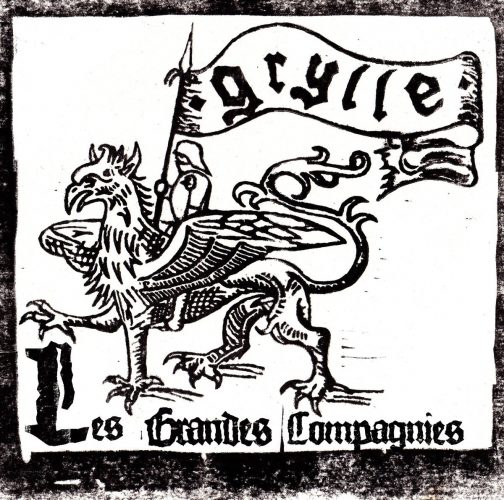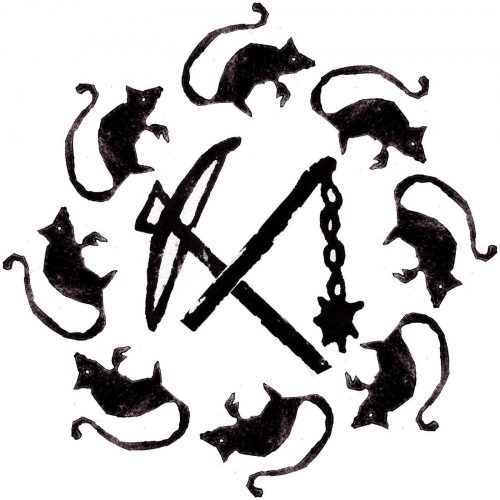Just two days ago, in introducing another premiere, I remarked that 2019 was shaping up to be a banner year for medieval black metal. In the forefront of my mind when I wrote that was this extraordinary album by Grylle. It’s not the only example I had in mind, but it stands in front. And perhaps paradoxically, an album that has proven to be one of the best of any genre I’ve heard this year (or likely will hear), in the midst of so much metallic extremity, is one performed almost entirely with acoustic instruments — and very old ones at that.
Les Grandes Compagnies is not stingy in its sharing of marvels either. It presents 11 tracks and more than an hour of music. Becoming immersed in it is quite easy. Leaving it behind 65 minutes later is very difficult. In some ways it’s like a time-traveling journey many centuries into the past, but not exactly like that. Rather than a pathway into a long-gone world that once did exist, it’s perhaps more like being transported into a world of the imagination, an ingenious hybrid of the ancient and the modern that exists only there.
The singular imagination that brought forth the album belongs to Hyvermor, a Frenchman who composed these 11 tracks, wrote the lyrics (borrowing from some old sources), and performed them with such instruments as flutes, psalterion, luthe, santoor, bass, and drums. He shared the vocal responsibilities with Griesche, who also performed flutes. And to further embellish the richness of the experience, he enlisted these guests in his own grande compagnie:
Trumpet, Saxhorn and Buggle Horn : Lazareth (Peste Noire, Anceisural Eritance, Braquemaard)
Mandolin : Björn (Peste Noire (live), Lemovice)
Vocals : Monarque (Monarque, Sanctuaire, Sacrenoir)
Krummhorn, Violas : Eduardo Antonello
You won’t find a single electric guitar in these lists of instruments. If you’re like me, you won’t miss them for an instant.
How, you may ask, can music be located within the realms of black metal when it has no electric guitar and a profusion of old acoustic instruments in its place? In part, it is a matter of the vocals, which are usually harsh and ugly — serrated, strangled, and scorching. In part it is a matter of the spirit and mood of the music, which is quite variable but generally cast in melancholy, bitter, and diabolical moods. That’s part of the hybrid quality of the songs; in addition to that, the music often rocks to the movement of head-moving drum beats that hadn’t been invented 500 years ago. (Yes, you can head-bang to medieval music when it’s paired with drumming this potent.)
The music has a vivid sound, with the slight echo of a performance in a chamber of old stone, with spires and gargoyles standing guard. The melodies are irresistibly beguiling, made magical by that feeling of being transported to another time and place drastically different from our own. An edge of danger occasionally surfaces. The music also becomes soft, introspective, and lush in its richness. Every song begins to seem like a present being unwrapped, each one providing some new dark joy.
The first time through the album, I felt like a light-headed adolescent, falling in love with each new song, each one like some new intoxicating sight passing me on the sidewalk, and then the next one, and the one that came next, each one turning my head with different allure. Some are mystical and haunting; some are lilting, and they dance. Some are steeped in loss, others are as bright as a wilderness stream in the sun, but just as lonely.
The character of the instruments is an enormous part of the appeal. I grew up in the American South, and some of the strumming has the backwoods resonance of a banjo, evoking waves of nostalgia, even if those aren’t banjos. The flute melodies are like spells. The bowing of the violas swings like an old folk dance, and weeps wretched tears. Sometimes you can hear Celtic airs, but the Celts seemed to be everywhere if you go back far enough.
And the instrumentation changes from song to song. The album seems calculated to give you a new sound of some kind with each one. Even by the eighth track, an instrumental named “Quand je bois du vin clairet”, which seemed to lead with an accordion (but it isn’t that instrument), I was still discovering surprises. And it doesn’t stop there. The vocals, by the way, shift as well, with clean song (both male and female) making almost as much of a contribution as all the goblin throats.
The music sparkles so often, yet is in pain. It whirls in delight, but lives on dirt floors and doesn’t have enough to eat. It sounds much more like the music of peasants than of lords. There is evanescent glory to be found here, and the agony of burying dead children. The joy in the music is fleeting and ever-haunted by the presence of death, the sounds of life when it knew it could be cut down suddenly, or in lingering misery, in its prime (and usually was).
But despite the long shadows in these sounds, there’s so much vibrancy, so much black magic. A truly remarkable album.
The care devoted to Les Grandes Compagnies doesn’t end with the music — which was beautifully mixed and mastered by Stefan Traunmüller (Rauhnacht, Golden Dawn, Wallachia, Véhémence). The album is being released tomorrow by Antiq Records with a 24-page booklet, each page printed from a hand-made engraving designed by Hyvermor and crafted by Theo Maeyens. The booklet presents the French lyrics, displayed in a text suitable to the music, with surrounding illustrations that are themselves a hybrid of ancient and modern, a form of surreal adornment in which Death haunts almost every page.
I would go on to describe the added special features of the limited edition of the album, but those copies are already sold out.
To order the CD or a digital edition of the album, go here:
BANDCAMP PRE-ORDER:
https://antiqofficial.bandcamp.com/album/grylle-les-grandes-compagnies
FACEBOOK:
https://www.facebook.com/grylleofficiel/



Awesome. Big thanks for this.
And we give big thanks to Grylle for working with us to do it!
2 bad they have a strong nsbm connection
Could you elaborate? I can’t find anything through Google.
I don’t think there’s anything to elaborate with, other than whatever inferences he’s drawing from the participation of a couple of guests who’ve performed with Peste Noir. I’m waiting to be corrected, but from what I know neither the principal artist nor the music has a damned thing to do with nsbm.
Thanks for the follow-up. Half the French scene has played with peste noir. I don’t like it, but I’d hardly call that a strong connection.